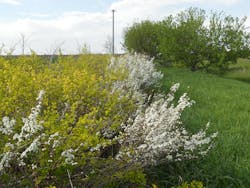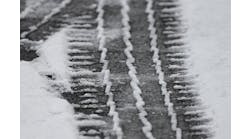In Iowa, preparation for snow season never ends. Much of the warm weather work takes the form of planning for and planting living snow fences.
Living snow fences as a concept are nothing new. Their use harkens back to the windbreaks that protected farmsteads in the 1930s. As early as the 1960s, the Iowa Highway Commission, the agency that later became the Iowa Department of Transportation (IDOT), began experimenting with planting trees and shrubs to serve as a defense against blowing and accumulating snow.
Over the intervening years, the design and plant materials used as living snow fences have been researched and refined, making them an efficient and cost-effective method of controlling blowing and drifting snow, while increasing safety for Iowa motorists.
In a time of tight budgets and the need to provide a significant return on every investment, IDOT is doing all it can to put permanent, living snow fences in place. The return on this investment can be significant in light of the research coming out of the Strategic Highway Research Program that indicates it costs 100 times more to plow snow than to trap it with a fence. Approximately 30% of U.S. states and nearly all Canadian provinces have living snow fence programs, although the designs vary widely due to typography and climate.
In addition to reducing snow removal costs significantly, using living snow fences provides numerous practical safety benefits.
Snowfence in spring, beautifying the roadside.
Safe, safer, safest
If you’ve ever driven through Iowa in the winter, you know visibility from blowing snow can impair a driver’s ability to see not only the road, but other vehicles. To address this visibility issue, living snow fencing breaks the wind and allows the snow to drop to the ground, rather than blowing through the air.
When the snow falls to the ground near the snow fence, it doesn’t accumulate on the road and that reduces the need for plowing and improving the surface conditions for better traction. Improved roadway conditions and visibility help drivers both see and avoid possible dangers.
Research in Wyoming has shown that blowing snow hyper-cools pavement. When snow fences prevent the snow from blowing across the pavement, the roadway temperatures remain closer to ground temperature, allowing deicing chemicals to be more effective. Research has shown when pavement temperatures dip below 20°F, the chemicals become less effective and can even create increased icing conditions, as refreeze can occur.
Snow drifts are themselves an obvious hazard to motorists. Strategic placement of snow fencing can direct snow to drift in the roadsides, rather than on the shoulder and pavement surface. Once a storm has ended, snow sifting becomes an issue, as snow on the ground can blow onto the roadway where it can melt and refreeze, causing icy conditions. A snow fence placed in the correct configuration can reduce sifting snow as well.
What’s more, there are ecological benefits to snow fence implementation. The plant materials employed in living fences take in the carbon from vehicle exhaust and release oxygen, improving air quality. Roadside plantings provide food and shelter for song birds, pollinators and other insects. Though concern exists that plantings placed in the right-of-way may attract wildlife and create hazards for motorists, IDOT has not documented an increase in animal crashes in areas where living snow fences are in place. Additionally, just as snow fences act as a windbreak to control snow blowing onto the highway, they also work to protect young crops from the drying effects of wind during spring and early summer, which can aid farmers season to season.
Finally—and it’s no small thing—living snow fences are aesthetically pleasing. Travelers through Iowa often comment on the beauty of the roadsides. IDOT takes pride in not only the practical, but the visual benefits of roadside plantings. Often snow fence shrubs have showy flowers in spring, fruit in summer and/or attractive fall color. These accents to the landscape break up the monotony on long stretches of highway and reduce “highway hypnosis” sometimes experienced by drivers on extended treks.
Snow fences also act as a visual buffer for neighboring properties, screening both a view of the highway for property owners and a view of the adjacent properties for travelers.
Standing corn left unharvested to serve as a snow fence.
It’s all in the details
Iowa’s living snow fence program, like all snow fence programs, is space dependent. A typical Iowa design includes two rows of closely planted shrubs. Shrubs are planted 4 ft apart within the row, and the rows are set 5 ft apart. Plants are staggered between the rows to fill gaps. This arrangement provides a snow fence that has approximately 50% porosity to maximize the amount of snow captured using the least amount of space.
IDOT research shows snow drifts from this fence design will extend approximately 10 to 12 times the height of the living snow fence. Thus, a snow fence using shrubs that will reach 10 ft in height will cause a drift approximately 120 ft in length. The more porous the snow fence, the longer and more shallow the drifts. More dense snow fencing results in shorter, deeper drifts.
To improve plant survivability, all plantings utilize a fabric barrier and 3 in. of shredded bark mulch around the shrubs. To assure a quality product, Iowa living snow fence specifications are performance-based. Contractor payment is based on plant survival rates over the first and second growing seasons. The upfront cost of a living snow fence is higher than traditional structural fencing. Costs are approximately $50 per shrub, which includes mulch, fabric and staples. One 100-ft station requires 50 shrubs at a cost of around $2,500. This cost also includes two years of contractor maintenance and two replacements of any dead plant material.
Where additional space is available, rows of trees are added to provide an additional level of protection for blowing snow. This is particularly helpful in very open areas where the prevailing winds blow across the roadway.
Where space is limited, native grasses and wildflower mixtures can add to surface roughness that helps control blowing and drifting snow. Many of Iowa’s native prairie plant species stand up better under the weight of winter precipitation, allowing the plants to trap snow and provide a wildlife habitat.
Figure 1. Diagram of a typical snow fence plot.
Partnering with owners
IDOT, in partnership with the U.S. Department of Agriculture’s Natural Resources Conservation Service and the Farm Service Agency through the Conservation Reserve Program, provides incentives to local landowners to plant living snow fences as well as native grasses and wildflowers on private property adjacent to roadways.
For this program, the land must be on the north or west side of the roadway. There is a 50% cost share with a 40% practice incentive payment for establishment costs. Rental price is based on the maximum soil rental rate with 10- and 15-year contract lengths available. The program also offers bonus payments for the first year of practice.
While site conditions will determine the final design of any living snow fence, a typical project from the fence line would include native grasses, one row of conifers, and one row of shrubs with the prevailing wind hitting the shrub row first. Iowa farmers understand the value of keeping roads clear in the winter. In several areas, local highway maintenance supervisors work with area farmers to identify areas where leaving rows of standing corn over the winter would be beneficial to the traveling public.
Depending on the distance from the field to the edge of the roadway, eight to 16 rows of corn are left standing in the fall to serve as a snow fence. The farmer is paid the market value for the estimated yield left in the field. In the past, landowners have arranged to have service organizations pick the corn by hand and sell it to benefit their organizations. Events such as this may be tax-deductible and also offer a community service for the area.
IDOT has been researching and planting living snow fences since the 1960s. While the upfront cost of snow control through plantings is higher than simply installing structural snow fencing, the lifecycle costs are actually lower. The typical life of a structural snow fence is 10 years. Iowa has living snow fences in place that have been providing excellent results for nearly 50 years.


